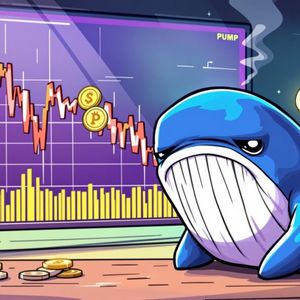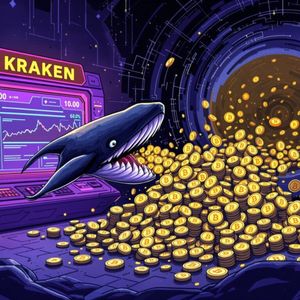NFT Whale Loss: The Stunning $3.86 Million Blow to Machi Big Brother
6 min read
BitcoinWorld NFT Whale Loss: The Stunning $3.86 Million Blow to Machi Big Brother The cryptocurrency world is no stranger to dramatic swings, but recent news has sent ripples through the community: a prominent NFT whale loss of millions. Machi Big Brother, a well-known figure in the NFT space, is currently facing a staggering floating loss on his PUMP token long position. This significant event serves as a stark reminder of the inherent volatility and risks within the digital asset landscape, especially when dealing with leveraged positions. What Exactly Happened with This NFT Whale Loss? At the heart of this unfolding story is Machi Big Brother, an influential collector whose on-chain movements are often scrutinized. According to insights from OnchainLens on X, Machi Big Brother is grappling with a substantial $3.86 million floating loss specifically tied to his PUMP (5x) long position. This loss materialized as the PUMP token’s price dipped below his initial purchase point, turning what was likely an optimistic bet into a challenging situation. It’s important to understand what a “floating loss” means. Unlike a realized loss, which occurs when an asset is sold at a lower price, a floating loss (or unrealized loss) is the theoretical loss on an open position. If the price recovers, the floating loss can diminish or even turn into a profit. However, if the price continues to fall, the loss could become permanent upon liquidation or sale. The PUMP token isn’t the only position contributing to the NFT whale’s current predicament. OnchainLens further revealed that Machi Big Brother also holds other leveraged long positions, specifically in ETH (25x) and HYPE (5x). When factoring in these additional positions, his total floating loss accumulates to an alarming $2.3 million across his portfolio. This broader picture highlights the compounding effect of market downturns on diversified, leveraged portfolios, culminating in a significant NFT whale loss . Understanding the Perilous Path of Leverage and the NFT Whale Loss The mention of “5x” and “25x” in Machi Big Brother’s positions is crucial. These numbers signify the leverage applied to his trades. Leverage allows traders to control a larger position with a relatively smaller amount of capital. For instance, a 5x leverage means that for every $1 of capital, the trader can control $5 worth of the asset. While leverage can amplify gains, it equally amplifies losses, making it a double-edged sword in volatile markets. Consider the implications of 25x leverage on an ETH position. A mere 4% drop in ETH’s price could wipe out the entire initial capital invested in that leveraged position, leading to a liquidation. This inherent risk is why seasoned investors often caution against excessive leverage, especially for assets known for their price swings, like many cryptocurrencies and new tokens such as PUMP. The situation with the PUMP token underscores another critical aspect: the risk associated with newer, less established assets. While they can offer explosive growth, they often lack the liquidity and stability of more mature cryptocurrencies, making them particularly susceptible to sudden price corrections and contributing to a substantial NFT whale loss . What Lessons Can We Learn from This NFT Whale Loss? The financial struggles faced by Machi Big Brother offer valuable insights for all participants in the crypto market. Understanding these lessons can help mitigate future risks and foster a more resilient investment approach. Volatility is Constant: The crypto market is inherently volatile. Prices can fluctuate wildly due to news, sentiment, or regulatory changes. Leverage Amplifies Everything: While tempting for maximizing gains, leverage dramatically increases exposure to market movements. Even small price drops can trigger liquidations. Diversification is Key: Relying heavily on a single asset can be risky. Diversifying across different asset classes, and even within crypto, can help spread risk. Due Diligence is Paramount: Especially for newer tokens, thorough research into the project’s fundamentals, team, use case, and tokenomics is crucial. Risk Management Strategies: Implementing robust risk management is non-negotiable. This includes setting stop-loss orders to limit potential downside and never investing more than you can afford to lose. The experience of this NFT whale loss underscores that even deep pockets don’t guarantee immunity from market forces. It reinforces the need for strategic planning and disciplined execution in an environment where market sentiment can shift rapidly. Navigating Crypto Risks After the NFT Whale Loss For individuals looking to navigate the treacherous waters of cryptocurrency investing, especially in the wake of significant events like the recent NFT whale loss , adopting a disciplined and informed approach is paramount. Here are some actionable insights to consider: For Investors: Start Small and Learn: Begin with smaller investments in well-established assets. Gradually increase exposure as you gain experience. Understand the Underlying Technology: Don’t just chase hype. Learn about blockchain technology and the specific use cases of the cryptocurrencies you invest in. Beware of “FOMO”: Fear of missing out often leads to impulsive decisions. Avoid making investment choices based solely on social media trends. Regularly Reassess Your Portfolio: Market conditions change. Periodically review your portfolio and adjust your holdings according to your risk tolerance. For Traders: Define Your Risk Tolerance: Before entering any trade, determine how much you are willing to lose. Stick to this limit rigorously. Utilize Stop-Loss Orders: These automated orders sell your asset if it drops to a certain price, effectively limiting your potential loss. Avoid Over-Leveraging: While leverage can magnify profits, it also magnifies losses. Be extremely cautious with high leverage, especially in volatile markets. Stay Informed, But Filter Noise: Follow reputable news sources and on-chain analytics, but be wary of speculative “calls” or unsubstantiated claims on social media. The PUMP token’s downturn and the subsequent NFT whale loss highlight the importance of not just understanding market dynamics, but also personal financial discipline. The crypto market offers immense opportunities, but they come hand-in-hand with significant risks that demand respect and careful consideration. The recent financial setback experienced by Machi Big Brother, culminating in a multi-million dollar NFT whale loss on his PUMP and other leveraged positions, serves as a powerful cautionary tale for the entire cryptocurrency ecosystem. It vividly illustrates the perils of high leverage, the inherent volatility of digital assets, and the critical importance of robust risk management strategies. While the allure of significant gains is undeniable, this incident reminds us that even the most prominent players are susceptible to market forces. As the crypto landscape continues to evolve, investors and traders alike must prioritize education, conduct thorough due diligence, and cultivate a disciplined approach to safeguard their assets and navigate the unpredictable currents of this exciting yet challenging frontier. The ultimate takeaway is clear: understanding and respecting market risks is paramount to long-term success in the world of digital finance. Frequently Asked Questions (FAQs) What is an NFT whale? An NFT whale is an individual or entity holding a very large and influential collection of non-fungible tokens (NFTs), often capable of impacting market trends due to their significant holdings and trading activity. What is a floating loss in cryptocurrency? A floating loss, or unrealized loss, is the theoretical loss on an open investment position. It occurs when the current market price of an asset is lower than its purchase price, but the asset has not yet been sold. If the price recovers, the floating loss can disappear. How does leverage affect crypto trading? Leverage allows traders to open positions larger than their initial capital. While it can magnify profits from small price movements, it also significantly amplifies losses. High leverage increases the risk of liquidation, where your position is automatically closed if the market moves against you by a small percentage. What is the PUMP token? The PUMP token is a specific cryptocurrency mentioned in the context of Machi Big Brother’s significant long position. Like many newer or niche tokens, it can be highly volatile and susceptible to rapid price changes, contributing to potential large gains or losses. How can I protect myself from significant crypto losses? Key strategies include understanding and managing risk, avoiding excessive leverage, diversifying your portfolio across different assets, conducting thorough research (due diligence) before investing, and utilizing risk management tools like stop-loss orders to limit potential downsides. Did you find this analysis of the NFT whale loss insightful? Share this article with your friends, fellow crypto enthusiasts, and on your social media channels to spread awareness about crucial risk management in the volatile world of digital assets! To learn more about the latest crypto market trends, explore our article on key developments shaping cryptocurrency price action. This post NFT Whale Loss: The Stunning $3.86 Million Blow to Machi Big Brother first appeared on BitcoinWorld and is written by Editorial Team

Source: Bitcoin World


